Easy + Delicious Paleo Calamari Recipe
Crunchy, chewy, salty, piquant…
Very few foods hit so many culinary categories the way a plate of golden fried calamari does.
Fried calamari is an appetizer that feels like a decadent indulgence. Crisp on the outside, chewy on the inside. It’s an ideal start to a Mediterranean meal or unique accompaniment to a bottle of wine with friends.
But with the good comes the bad. While this this nutrient-rich seafood snack is undoubtedly crave-worthy, it is usually covered in wheat flour and then fried in oil that is downright dangerous to your health. Like most conventionally fried foods, the average breaded and fried calamari, contributes to an unhappy gut, while promoting inflammation and oxidative stress in the body.
We wouldn’t fault you for believing that’s the end all be all—a double whammy that leaves beloved fried calamari out of the question.
But where there’s a will… there’s a way! Besides, calamari isn’t just delicious – it’s also packed with health benefits.
The Health Benefits of Calamari
Known to boost immunity and digestive health, squid is one of the ocean’s best kept secrets. It’s not only a hearty portion of protein (3 ounces gives you 15 grams) but also an excellent source of vitamins and minerals.
Like many of its underwater neighbors, squid is packed with B vitamins which boost energy levels and metabolic health. One of these is vitamin B12, which is vital for proper methylation, heart and brain health, detoxification and more. It is also rich in copper, which can help your body absorb other critical minerals found in calamari, like selenium and phosphorus.
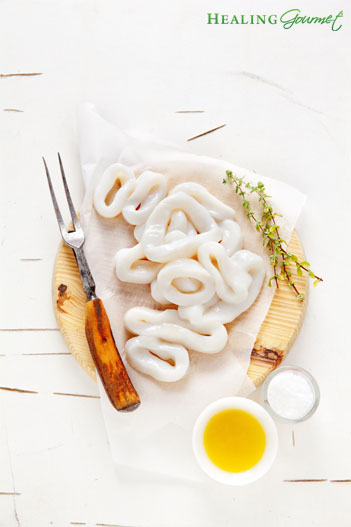 Even more, calamari is low in fat, which is good news when it comes to our unfortunately polluted modern oceans. You see, because most toxins are lipid-soluble, they are stored in fat tissue. Since calamari doesn’t have much fat, it is less likely to be contaminated with dangerous PCBs (polychlorinated biphenyls) from the ocean.
Even more, calamari is low in fat, which is good news when it comes to our unfortunately polluted modern oceans. You see, because most toxins are lipid-soluble, they are stored in fat tissue. Since calamari doesn’t have much fat, it is less likely to be contaminated with dangerous PCBs (polychlorinated biphenyls) from the ocean.
On top of these nutritional bonuses, calamari is also considered a sustainable source of seafood. Squid reproduce quickly and their populations are not in danger, as are other species. Fishermen are also able to catch squid, without the considerable “bycatch” (accidentally caught fish) that are common with other ocean resources.
Fried Calamari… The Healthy Way
Of course, you can always enjoy calamari Sicilian style (sautéed). And you can add it to a delicious seafood stew. But there’s something about sinking your teeth into the golden-fried variety that is so irresistible.
Of course, fat adds flavor to foods and helps flavors linger longer in your mouth. It is also a vital macronutrient with myriad functions in your body. It boosts absorption of important nutrients (including A,E,D,K as well as lipid soluble phytonutrients like lutein and other carotenoids). It keeps you feeling full. It is required for the production of vital steroid hormones, helps to balance blood sugar… and even boosts mood and eases depression.
But the key is choosing the right fats and using them the right way.
Conventional frying processes use dangerous GMO-soybean oil, canola oil or vegetable oil. These oils aren’t just highly processed, they are also a rich source of omega 6 fats that promote inflammation and oxidation and increase the risk of obesity and disease. The frying process itself causes the delicate omega 6 fats to degrade further, producing more free radicals and harmful lipid oxidation product (LOPs).
To beat the woes of conventional frying, we swapped out the bad… for the best. In the recipe below, our combination of coconut oil and avocado oil is packed with antioxidant-rich monounsaturated fats that benefit your waistline and your heart. Since these oils are very heat stable, you can fry gently without being exposed to the harmful toxins that accompany traditional frying oils.
Now that we’ve tackled the frying oil and the squid, onto that golden-crisp coating…
Recommended: Kindle Your ‘Internal Fat Furnace’ with THIS cooking hack
A Golden, Crispy & Grain-Free Calamari Recipe
Is it really possible to re-create the salty, crunchy outside of fried calamari… without gluten or grains? You bet!
Using a carefully measured blend of coconut and tapioca flour, our calamari recipe develops that authentic, crispy goodness… without the health consequences of refined flour, gluten or grain. Equally impressive: our Paleo calamari has just 14 grams of carbohydrate per golden-kissed serving.
If you’ve never fried anything, don’t worry. This recipe is exceptionally easy with step by step tips below.
So, let’s get cooking!
Paleo Calamari Recipe: The Simple Step By Step
First, select your calamari. You can choose frozen wild calamari or fresh. The latter requires a good bit more work.
Most calamari connoisseurs contend that fresh squid is required to make really good fried calamari, so that’s what we did. And at $2.49/lb, you can see our wild caught New Zealand squid is very affordable.
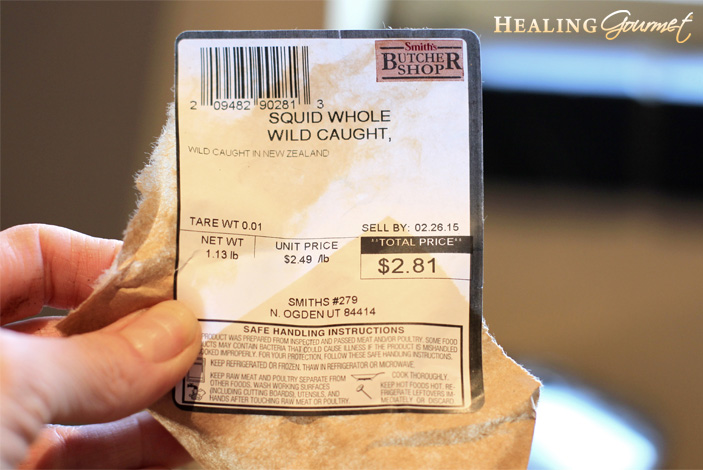
An important disclaimer before you get started: the process of cleaning calamari is not for the faint of heart. You’ll discover egg sacks, peel away skin, remove squid beaks and encounter some other “icky” things. With that said, this is a great opportunity to involve the family and give your little ones an understanding and appreciation of where their food comes from.
The first thing you want to do is trim the tentacles, just above the eyes, and separate those from the bodies. Then remove the beak from the tentacle portion.
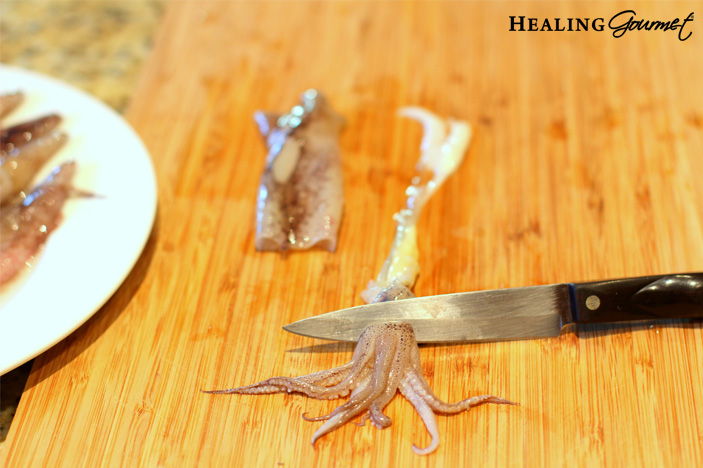
Place the body tubes on a plate.
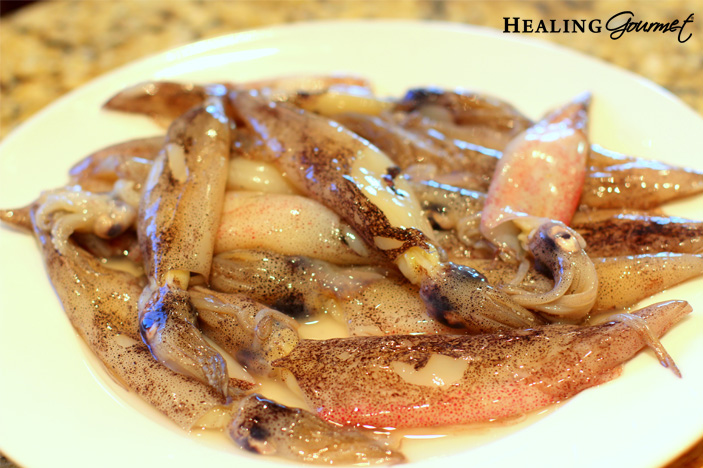
Now for the fun part. You will need to remove the quill, the squids’ insides…
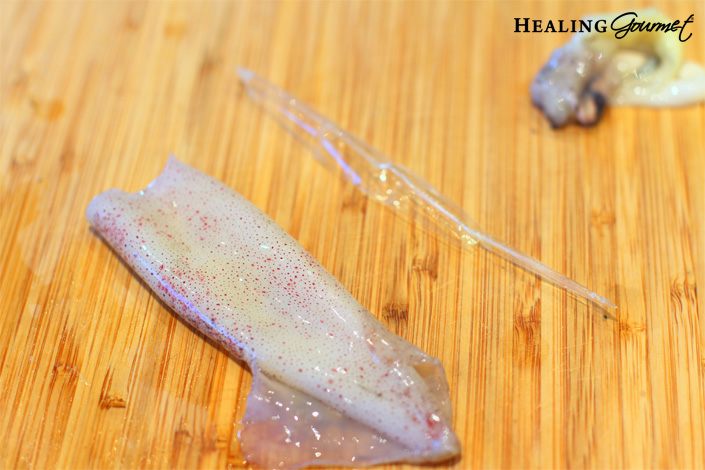
And peel the skin.
Here is a video that details the calamari cleaning process:

Then cut the tubes into ¼- ½ inch rounds. Rinse the cleaned calamari well and place on paper towels. Pat to dry. It is best if you do this a good bit ahead of time, drying the calamari and spreading in a single layer on a paper towel and letting the additional moisture dissipate. When frying, moisture can mean “oil pops”, so please be very cautious.
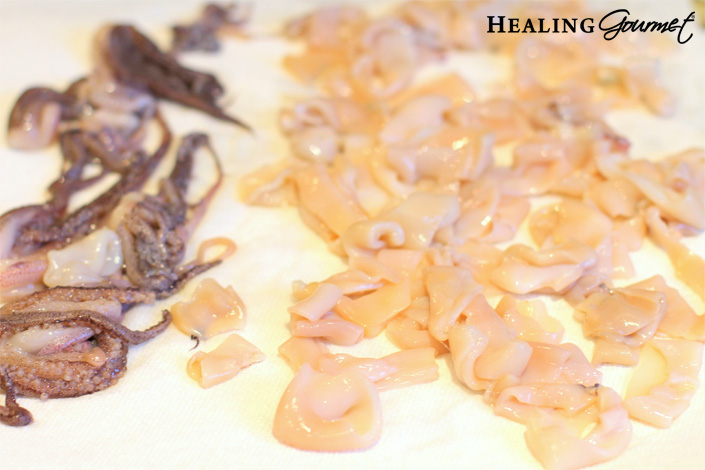
While your calamari dries, get the batter going. In a medium bowl, whisk together the tapioca flour, coconut flour, salt and seasonings. In another bowl, whisk the eggs and coconut milk.
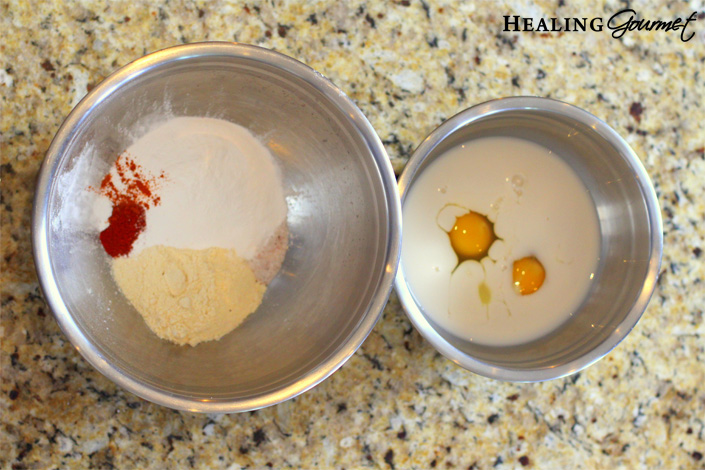
Add the wet ingredients to the dry and mix well to form a batter.
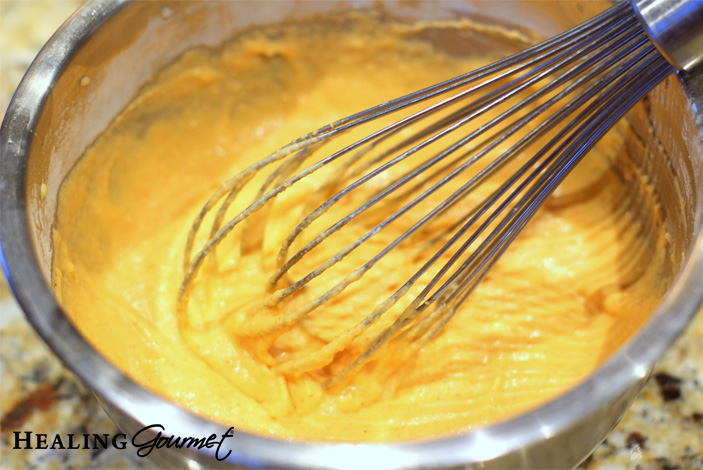
It should be thick enough to coat your whisk like this…

In a heavy-bottomed sauté pan, add the oil and heat over low. Also slice a lemon or two and open a jar of Organic Marinara Sauce and get that warmed up. If you really want to make it an experience, add some pepperoncini peppers, Kalamata olives or cherry peppers sautéed in garlic. Also, prepare a sheet pan with a paper towel lined grate for placing the finished calamari.
Working in batches, dip calamari into the batter, swirling to fully coat the rings…
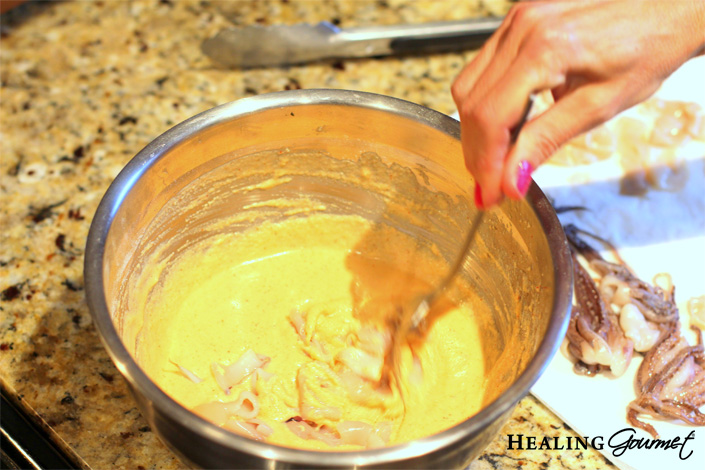
Then gently drop into the hot oil, separating the pieces and ensuring you don’t crowd the pan.
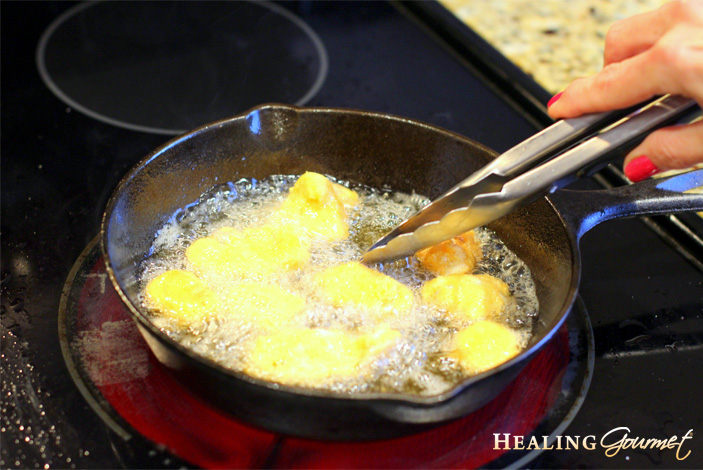
Work in batches, and transfer your cooked calamari to your paper-towel lined sheet pan, then serve.

With this crispy calamari recipe, you can enjoy more of squid’s goodness… without filling up on heaps of breading. So go ahead, dip another ring in that marinara sauce. How could you not? Our Paleo Fried Calamari recipe hits the crisp without the grain and adds a boost of heart-healthy fats that lift you up instead of weighing you down.
So when you want to indulge in a crispy fried treat, do it at home. You’ll have more control over the source of the ingredients, while avoiding harmful industrial oils and gluten to boot.
Mange!
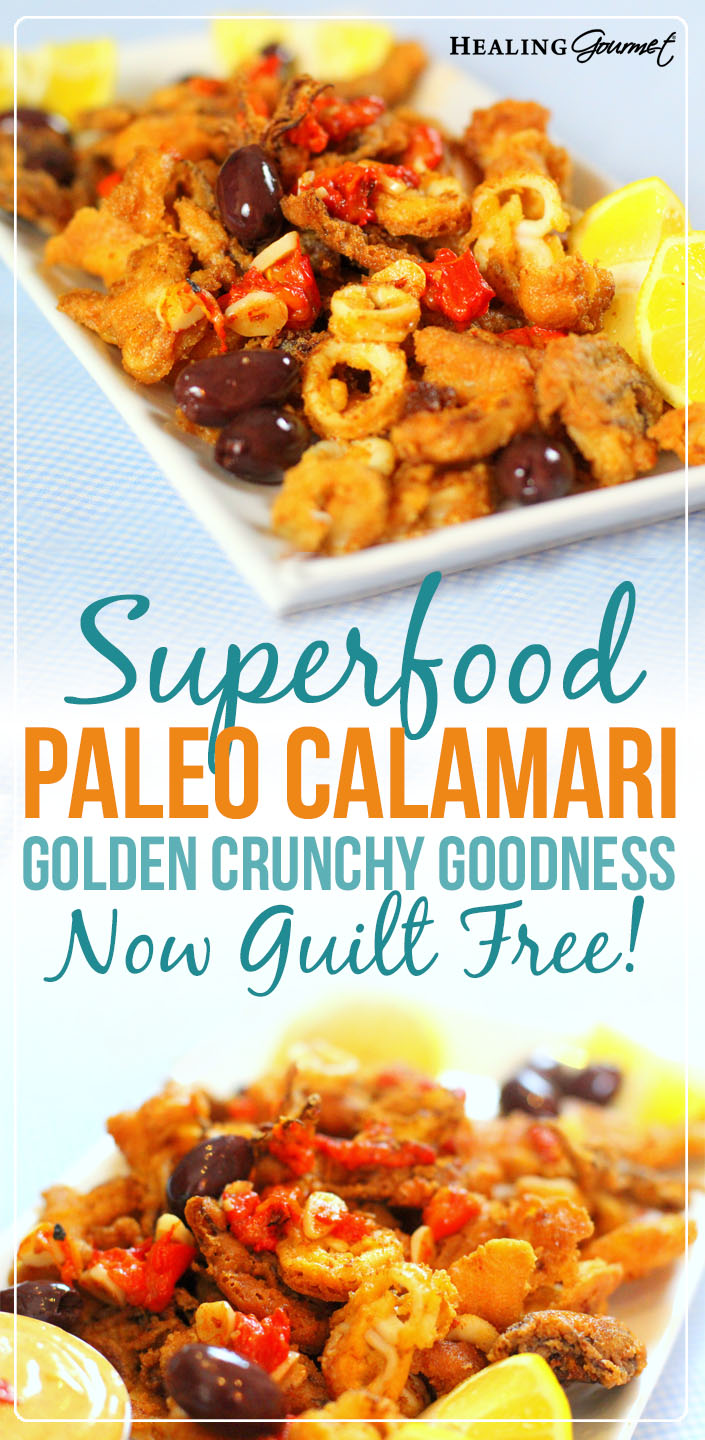
Original
Prep Time
20 mins
Cook Time
15 mins
Total Time
35 mins
Servings
6
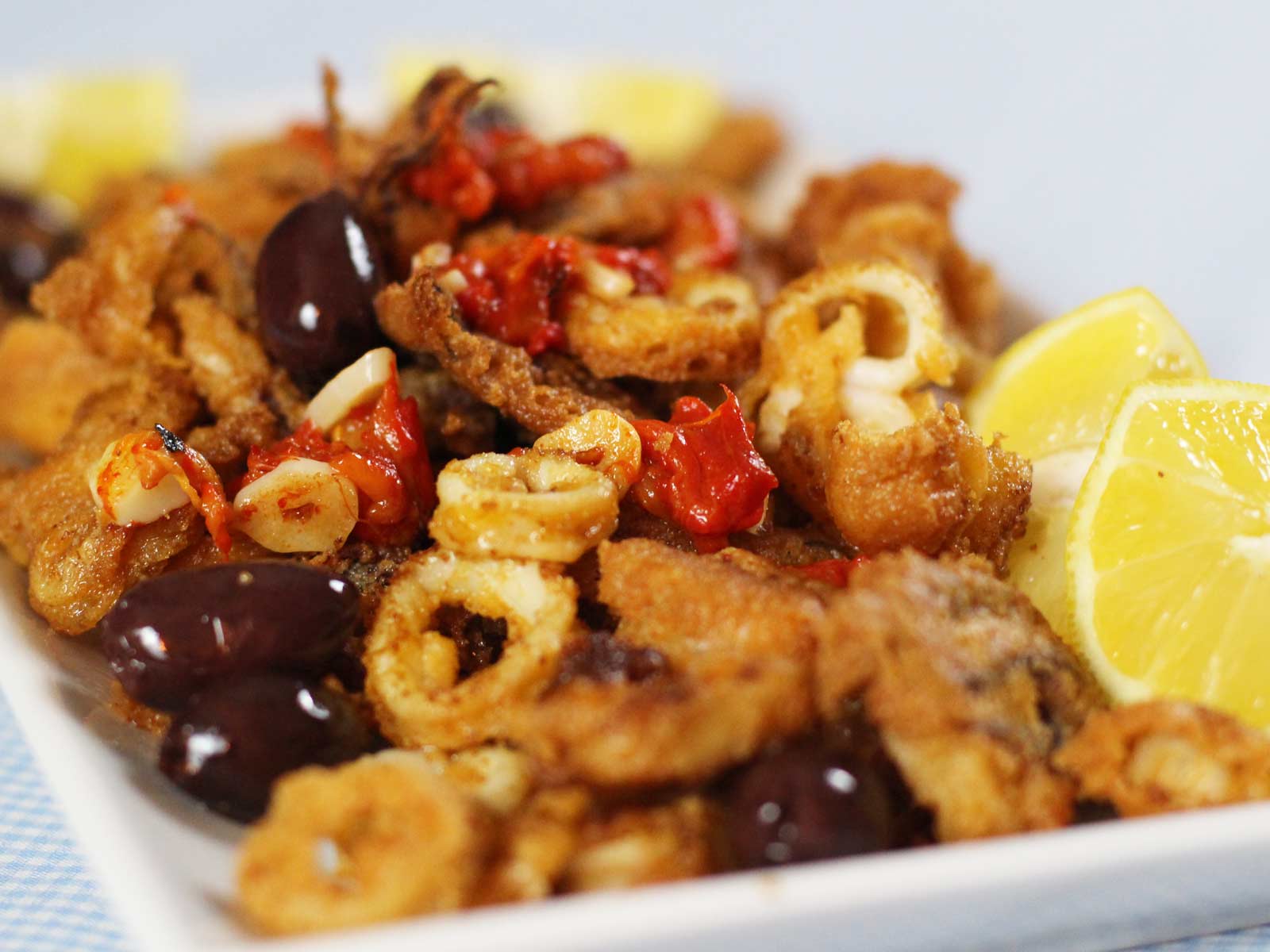
Ingredients
Squid
- 300 g cleaned calamari (about a pound whole calamari) or 1 lb. frozen calamari, thawed
Dry Ingredients (Batter)
- ½ cup tapioca flour
- ¼ cup coconut flour
- ½ tsp. sea salt
- 1/8 tsp. cayenne (optional)
- 1 tsp. smoked paprika (optional)
Wet ingredients (Batter)
- 2 eggs
- ¾ cup full fat coconut milk
Frying Oil
- ½ cup coconut oil + ½ cup avocado oil (for frying)
Accompaniments (Choose Your Experience)
- 1 lemon, sliced into wedges
- Organic pepperoncini peppers or cherry peppers, sautéed with fresh garlic
- Kalamata olives
- 1 jar Organic Marinara Sauce
- Paleo Remoulade
Instructions
- Clean the calamari as described above. Prepare your accompaniments. Get a sheet pan with a paper-towel lined grate ready to transfer the cooked calamari onto.
- Prepare a heavy-bottomed skillet (cast iron is preferable) with the coconut oil and avocado oil. Heat over very low heat to melt. Get a splatter screen ready if you have one.
- In a small bowl, whisk together the dry ingredients.
- In a medium bowl, whisk together the wet ingredients.
- Add the dry ingredients into the wet, whisking well.
- Set the cleaned, dried calamari up next to the batter. Set the sheet pan up so you’re ready to transfer the cooked calamari.
- Increase the heat to medium, around 250 F if you have a candy thermometer.
- Using a fork, dip the calamari into the batter, a few pieces at a time, swirling to coat. You want to fully cover the calamari, but still let the ring shapes show so you don’t have a “fritter”.
- Gently place the coated calamari into the preheated oil and cook until golden, about 2 minutes, turning. Add as much calamari to the pan as you can without crowding.
- Using tongs, transfer the cooked calamari to the lined pan and continue cooking calamari in batches.
- Serve immediately.
Nutrition & Macronutrient Ratio
Nutrition Information Per Serving (Without Accompaniments)
264 calories, 16 g fat, 7 g saturated fat, 6 g monounsaturated fat, 2 g polyunsaturated fat, 244 mg cholesterol, 14 g carbohydrate, 0 g sugar, 2 g fiber, 15 g protein
Excellent Source of: Protein, Selenium, Copper, Riboflavin, EPA/DHA Omega-3, Phosphorous
Good Source of: Iron, Vitamin B12, Manganese
*Because only 3 Tbsp. of the oil will be absorbed into the calamari, nutrition information here reflects that.
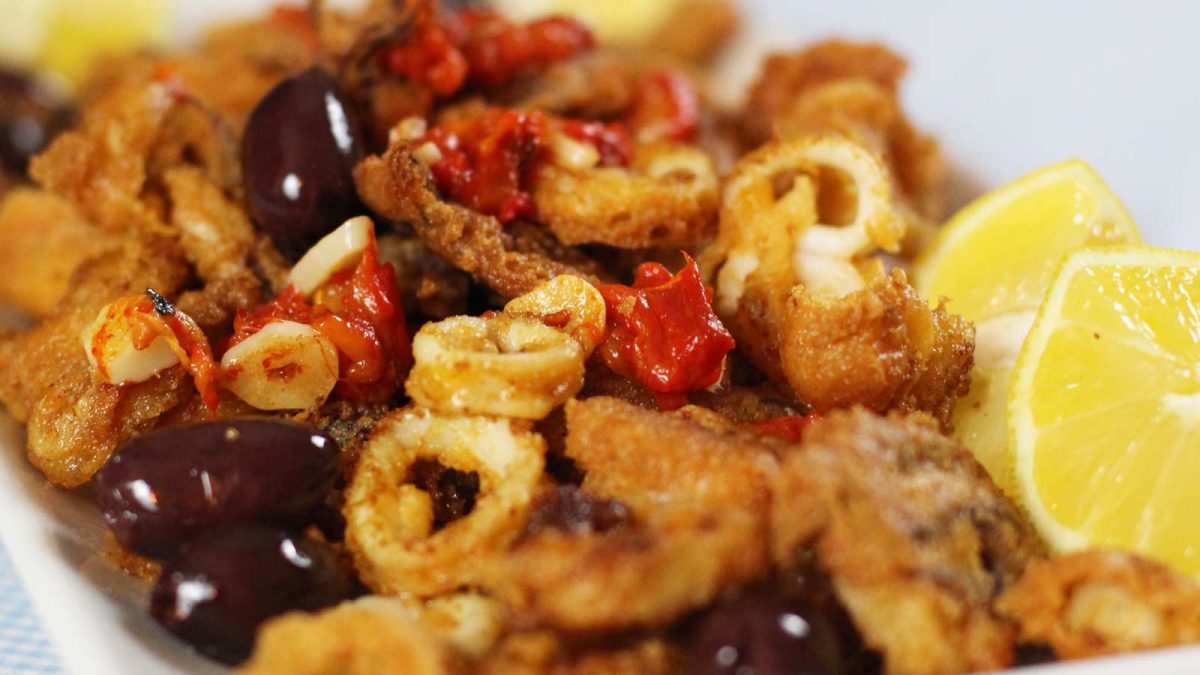

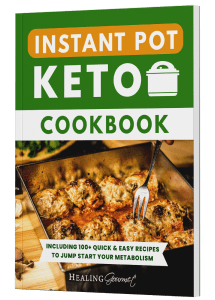
Kelley,That is a great idea. I’m glad to see you doing this recipe. I am from Italian heritage,and have eaten this for years the traditional way with wheat flour,until I cleaned up my diet. I haven’t eaten this for a while,because of the wheat and frying, So I will be doing the recipe this way. Thanks
Can I substitute tapioca flour with almond flour?
Hi Mary Ann,
Unfortunately, I don’t think that substitute will work. Coconut flour may as it is finer and will have more surface area for adhering. But starch really adheres the best and creates a nice crust.
If you try an alternate flour, please let us know how it goes!
Kelley